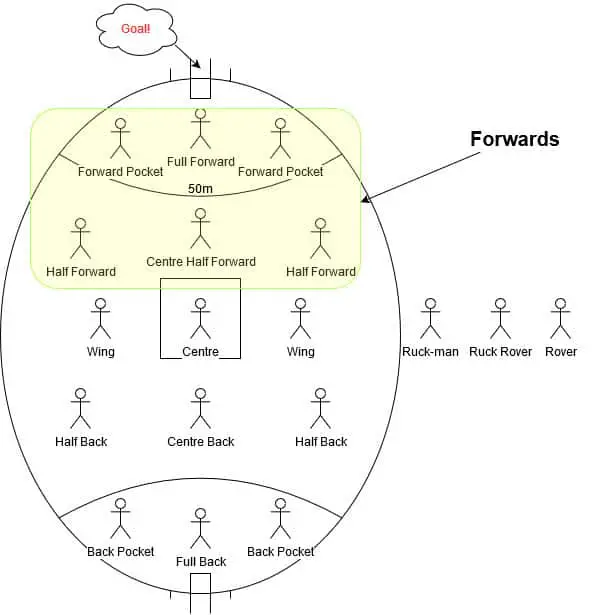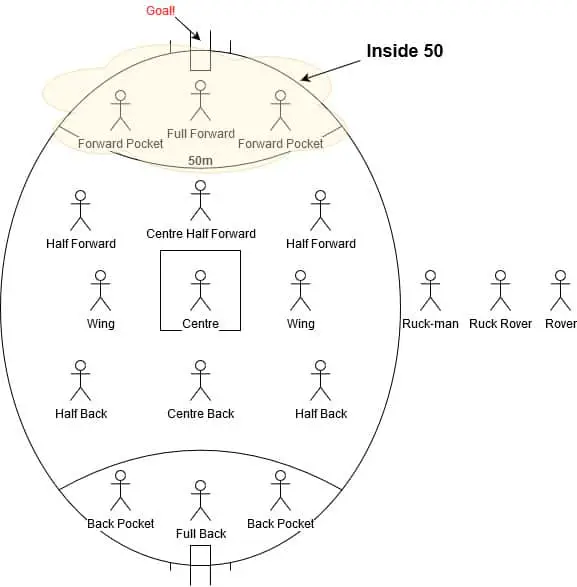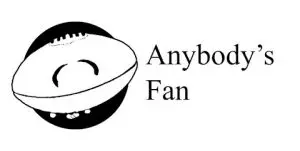When I was a kid, I used to play as a forward on my local footy team. Often I finished the hard work of the midfielders in my team who would win the ball from the centre and put it in the area for me and my fellow forwards to score. After writing recently about midfielders (my guide is here), I recalled my time as a forward and thought I’d put together a guide to the forward positions as well.
The forward line of an AFL team consists of full forwards and half forwards whose objective is to receive the ball from the midfield and move it inside 50 to score. Key players on the forward line include the full forward, two forward pockets, the centre half forward, and two half forwards.

There is more to the forward line than just scoring. The different roles in the forward line can help achieve defensive objectives for the team as well. This gives an opportunity for players of different strengths and sizes to contribute to the forward line.
In this guide I’ll cover:
- What the different positions are
- Some tactics for forwards
- Measuring performance with inside 50’s and what a set shot is
- The greatest forwards I’ve ever seen
Forward Line Positions
In AFL, the forward line is traditionally made up of 6 positions – 2 lines of 3 players. These are:
- Full Forward Line, with forward pockets and the full forward
- Half Forward Line, with half forward flankers and the center half forward
Full Forward Line – Made up of two Forward Pockets and the Full Forward. These 3 players are closest to the goal and are responsible for scoring most of the team’s goals.
The Full Forward is the focal point of the attack and attracts most of the balls from the midfield towards him. The Forward Pockets play near the full forward and try to win the ball if the full forward is unable to mark it; I’ve noticed pockets tend to be smaller players than the full forward.
One of the forward pockets may also be a resting ruck-man or another tall player. This gives a secondary target – along with the full forward – for the midfield to kick the ball to. I wrote a whole guide on ruck positions and midfielders recently, to find out how damaging midfielders can be to an opposition team, check it out here.
Half Forward Line – The Half Forward line is the link between the midfield and the Full Forward line. It is made up of two half forward flankers and a Centre Half Forward
I reckon the Centre Half Forward is the toughest position on the ground. This position is the target for most team’s attacks when coming out of defence. While being a target, he is also expected to be the main source of scoring opportunities – once he receives the ball he usually has to kick a goal or pass it to a player who can. He doesn’t typically kick as many goals as the Full Forward however.
The Half Forward Flankers are required to support the centre half forward if he doesn’t mark the ball, much like the forward pockets playing off the full forward. These players may also push up the ground to give midfield support.
Forward Line: Roles and Types
The different roles on the forward line are assigned to players based on their physical attributes and strengths. These rolls include:
- Tall Forward
- Small Forward
- Defensive Forward
- Midfield Forward
- Ruck Forward
Tall Forward – These are the tall players in the forward line, as the name suggests. They usually take up the main positions of Full Forward and Centre Half Forward. Tall forwards are the focal point for the midfielder’s attacks, they are requried to try and mark the ball or provide a contest in the air.
Small Forward – These are the smaller and more mobile players. Traditionally the main job of the small forward was to stay near the tall forwards to fight for the ball at ground level if the tall player was unable to mark the ball. In modern times, the small forward role has changed – they are still required to fight for the ball if the tall players don’t mark it, but also to provide pressure on the defence and trap the ball in the forward half with constant pressure and tackling.
Defensive Forward – A specialty position, usually on a half forward flank. The main job of a defensive forward is to stop attacking defenders starting counter attacks from defence. Defensive forwards typically sacrifice getting the ball.
Midfield Forwards – Midfielders who rest in the forward line. When a midfielder is tired or struggling to get the ball to impact the game, one tactice by coaches is to place them in the forward line. Inside midfielders, who are usually bigger and stronger, and better markers, go play on the Full Forward line; outside midfielders use their creativity and speed to link with the midfield on the half forward line.
Ruck Forward – An athletic ruck man who rests in the forward line when tired, or as a tactic against a smaller defensive team. I would be intimidated if playing defence and saw this 200cm+ ruck-man coming forward toward me, even though in practice a lack of speed might make him virtually useless.
Inside 50: Explained

Inside 50 means getting the ball within the 50 metre line. How many times a team gets the ball inside 50 is an important indicator of a team’s performance.
The 50 metre line indicates 50 metres from goal, this is the arched ground marking on the field.
Getting the ball inside 50 gives the team more chance of scoring, and this is where the forwards do their best work.
An effective strategy I’ve seen for keeping the ball inside 50 is to set up a wall just outside the 50m line to keep the opposing team out while the forwards have the ball inside 50. Small forwards are important to this strategy due to their tackling and chasing pressure on defenders; keeping pressure on defenders and tiring them out helps prevent defenders breaking the wall.
What is a Set Shot?
A set shot is when a player has an unimpeded shot on goal resulting from a mark or free kick. A good set shot routine, that a player is comfortable with, is very important for a forward and many forwards have lost thee place in the teams and even there careers by having an inaccurate set shot.
I found it’s also important to reward the players up the ground, particularly the midfielders, a forward can break the trust of his teammates and there confidence if they continually do the hard work in getting the forward the ball, only for the forward to miss unforced shots on goal. This can provide intense pressure on a player, in recent years this pressure has increased further as the AFL introduced a Set-shot clock, giving players 30 seconds to have the shot immediately after a mark or free kick.
Greatest Forwards
I’ve put together a list of what I consider the greatest forwards I’ve ever seen.
Full Forwards
John Coleman – Arguably the greatest player of all time, John Coleman played only 5 seasons, but it was enough to have the league honor his name; the leading goal kicker each year winning the Coleman Medal. Coleman was a rock star, 12 goals in his first game and 100 in his first year. It was said that crowds of up to 10,000 would move from one side of the ground to the other between quarters to see him play. A week after he had kicked 15 goals in one game, he fell awkwardly, injuring his knee and would never play again. Many have said the injury would be repaired within a few weeks with surgery today. His tragically short career of just 98 games, resulted in a freakish 537 goals.
Tony Lockett – June 6 1999, I was 11 years old, but I still remember it like it was yesterday. It was the day that Gordon Coventry’s record of 60 years, a record many said would be impossible to break, finally fell. For two weeks leading up that day the nation went into a frenzy, the media dubbed it “Plugger Mania” as grown blokes wore Lockett masks and fat suits in honor and excitement of the impending record.
We all sat around our living rooms and pubs and collectively celebrated as he became the first man to reach 1300 goals (Coventry had ended his career on 1299). He was the games most fearsome player, with a mammoth 191cm and 123kg frame and it was widely regarded as the most courageous and crazy (almost life threatening) thing for a player to do was get in front of a rampaging Lockett. If he didn’t get the ball he would quite literally run through anything that stood between him and the ball and many players would regret standing in front of him.
But what a player he was! Speed, power and a beautiful kick, he was a champion in every sense first for the St Kilda Saints, where he would become the only full forward to win a Brownlow Medal and then as Sydney’s first mega star. He would kick a record 100 goals in a season 6 times and its hard to fathom that anyone will ever get near his tally of 1360 goals.
Midfield Forwards
Leigh Matthews – Nicknamed “Lethal” for his uncompromising attack on the ball and the opposition. Widely regarded as one of the greatest players of all time and officially voted as the player of the 20th century, Matthews dominated not only around the ground but also as a forward. In an era where interchange wasn’t as frequent, Matthews would rest for periods inside forward 50 to devastating effect. Short, but stocky, he was virtually impossible to tackle and would end his career with an insanely impressive 915 goals from 332 games.
Gary Ablett Snr – One of footballs greatest stories and probably the most naturally gifted player to ever play the game. The shy Ablett, who was from country Victoria started his career at Hawthorn, but could never settle in the big city of Melbourne. He would play just 6 games for the Hawks, before returning back to his home in Druin. After a year back home and at 23 years of age, he was convinced by Geelong to try the big leagues one more time. Ablett was more comfortable in the much quieter and rural city of Geelong thrived and would be an instant success. Playing mostly on a wing and half forward Ablett, would run forward at will and his long kicking meant he could score from a long way out. His goal kicking stats as a midfielder were remarkable and he often topped 70 goals for a season playing on a wing. As he got older he moved closer to goal, ending his career at full forward and becoming the only player in history to score 100 goals in 3 consecutive seasons. Is one of only five players to kick over 1000 career goals (1031).
Half Forwards
Wayne Carey – Simply known as the “King,” Carey was undoubtedly the player of his generation. Blessed with speed, endurance, strength and a wonderful leap, Carey could have played anywhere and would have starred. However mixing those athletic and physical attributes with a wonderful long kick Carey was the prototype Center Half Forward. His ability to win the ball and then either distribute to his full forward line further up the field or simply kick the long goal himself made him an unstoppable throughout the 90’s. 7 times an All-Australian, 2 MVP Awards and 2 premierships the highlights of one of the most decorated and at times controversial careers in AFL history.
Small Forwards
Cyril Rioli – The perfect modern day small forward. While he didn’t get much of the ball and wasn’t a goal kicking machine, even though he was able to score some freakish goals, Rioli’s pressure made him one of the most valuable players in the competition. His speed and pressure changed the role of the small forward and resulted in teams looking far and wide for their own small tackling machine.
Bottom Line
In the modern day game of footy, the forward line is as important to team defense as it is kicking goals. Trapping teams in their attacking areas and giving their midfielders and defenders a chance to set up walls outside their attacking 50 are important strategies for the forward line.
Forwards can also come in any shape, size, and skill set – the forward positions can be accessible to any player. Whether it’s the Tall Forward – capable of kicking tonnes of goals or causing physical harm and taking big marks; a skillful and strong half forward whose skills can get the scoreboard ticking over with laser like passing or the ability to kick long goals; or a fast freakish small player, tackling everything in sight and penning teams in their defensive end.
A forward line is as diverse as any place on an AFL field.
References
It’s been a while since I played forward positions, so I put some research in to make sure this post had all the latest details on modern forwards strategy. Here’s the list of what I used:
- A tutorial on player positions
- Coaching details on player positions
- Details from AFL coaching managers on setting up a forward line[PDF]
- An AFL explanation of inside 50
- News article about Set Shots
- AFL explains the Coleman medal
- John Coleman (Essendon’s history, stats, and they even named the medal after him)
- Tony Lockett biography
- About Leigh Matthews
- Gary Ablett: News article and Geelong’s history
- Wayne Carey sporting hall of fame
- Cyril Rioli in the news
Cass used to play in the forward lines in his under-18’s days.
